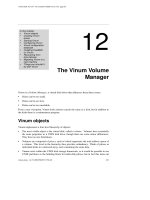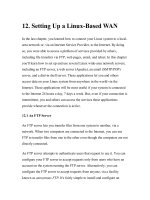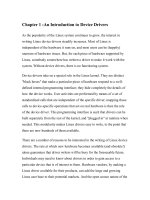linux crash course chapter 12 3
Bạn đang xem bản rút gọn của tài liệu. Xem và tải ngay bản đầy đủ của tài liệu tại đây (175.4 KB, 24 trang )
Chapter 12:
gawk
Yes it sounds funny
In this chapter …
•
•
•
•
•
Intro
Patterns
Actions
Control Structures
Putting it all together
gawk?
•
•
•
•
GNU awk
awk == Aho, Weinberger and Kernighan
Pattern processing language
Filters data and generates reports
gawk con’t
• Syntax:
gawk [options] [program] [file-list]
gawk [options] –f program-file [file-list]
• Essentially, program is a list of
things to pattern match, and then a
list of actions to perform
• Can either be on the command line or
in a file
gawk program
• A gawk program contains one or more
lines in the format pattern { action }
• Pattern is used to determine which
lines of data to select
• Action determines what to do with
those lines
• Default pattern is all lines
• Default action is to print the line
• Use single quotes around program on CL
Patterns
• Simple numeric or string comparisons
< <= == != >= >
• Regular expressions (see Appendix A)
– The ~ operator matches pattern
– The !~ operator does not match pattern
• Combinations using || (OR) and &&
(AND)
Patterns, con’t
• BEGIN – before any lines are processed
• END – after all lines are processed
• pattern1,pattern2 – a range, that
starts with pattern 1, and ends with
pattern2. After matching pattern2,
gawk attempts to match pattern1 again
Variables
• $0 – the current record (line)
• $1-$n – fields in current record
• FS – input field separator (default:
SPACE / TAB)
• NF – number of fields in record
• NR – current record number
• RS – input record separator (default:
NEWLINE)
• OFS – output field separator
• ORS – output record separator
Associative Arrays
• A variable type similar to an array,
but with strings as indexes (instead
of integers)
• Ex
– myAssocArray[name] = “Bob”
– myAssocArray[hometown] = “Austin”
• Ex
– studentGrades[123-45-6789] = 75
– studentGrades[987-65-4321] = 100
Pattern examples
• $1 ~ /^[A-Z]/
– Matches records where first field starts with a
capital letter
• $3 <= $5
– Matches records where the third field is less than
or equal to the fifth field
• $2 > 5000 && $1 !~ /exempt/
– Matches records where second field is greater
than 5000 and first field is not exempt
Functions
• length(str) – returns length of str
– Returns length of line if str omitted
• int(num) – returns integer portion of
num
• tolower(str) – coverts chars to lower
case
• toupper(str) – converts chars to upper
case
• substr(str,pos,len) – returns substring
of str starting at pos with length len
Actions
• Default action is print entire record
• Using print, can print out particular
parts (i.e., fields)
– Ex. { print $1 }
• Put literal strings in single quotes
• By default multiple parameters
catenated
– Use comma to use OFS
• Ex. { print $1, $5 }
Actions, con’t
• Separate multiple actions by semicolons
• Other actions usually involve variables
(i.e., incrementors, accumulators)
• Variables need not be formally
initialized
• By default set to zero or null
• Standard operators function normally
* / % + - = ++ -- += -= *= /= %=
Actions, con’t
• Instead of print you can use printf
(c-style)
• Syntax:
– printf “control-string”, arg1, arg2 … argn
contains one or more conversion
– %[-][[x].[y]]conv
– control-string
• - – left justify x – min field width y – decimal places
• conv: d – decimal f – floating point s – string
• Ex: %.2f – floating point with two decimal places
Control Structures
• gawk programs can utilize several
control structures
• Can use if-else, while, for, break
and continue
• All are C-style in syntax (what did
the K in gawk stand for?)
if … else
• Syntax:
if (condition)
{
commands
}
else
{
commands
}
while
• Syntax:
while (condition)
{
commands
}
for
• Syntax:
for (init; condition; increment)
{
commands
}
• You can use break and continue for
both for and while loops
Examples
•
•
•
•
•
•
•
•
•
gawk
gawk
gawk
gawk
gawk
gawk
gawk
gawk
gawk
‘{print}’ cars
‘/chevy/’ cars
‘{print $3, $1}’ cars
‘/chevy/ {print $3, $1} cars
‘$1 ~ /^h/’ cars
‘2000 <= $5 && $5 < 9000’ cars
‘/volvo/ , /bmw/’ cars
‘{print $3, $1, “$” $5}’ cars
‘BEGIN {print “Car Info”}’ cars
Putting it all together
BEGIN{
print "
Miles"
print "Make
Model
Year
(000)
Price"
print \
"--------------------------------------------------"
}
{
if ($1 ~ /ply/) $1 = "plymouth"
if ($1 ~ /chev/) $1 = "chevrolet"
printf "%-10s %-8s
%2d
%5d
$ %8.2f\n",\
$1, $2, $3, $4, $5
}
Results
gawk -f printf_demo cars
Miles
Make
Model
Year
(000)
Price
-------------------------------------------------plymouth
fury
1970
73
$ 2500.00
chevrolet malibu
1999
60
$ 3000.00
ford
mustang
1965
45
$ 10000.00
volvo
s80
1998
102
$ 9850.00
ford
thundbd
2003
15
$ 10500.00
chevrolet malibu
2000
50
$ 3500.00
bmw
325i
1985
115
$
450.00
honda
accord
2001
30
$ 6000.00
ford
taurus
2004
10
$ 17000.00
toyota
rav4
2002
180
$
750.00
chevrolet impala
1985
85
$ 1550.00
ford
explor
2003
25
$ 9500.00
Associative Arrays
• gawk ‘ {manuf[$1]++}
END {for(name in manuf) print name,\
manuf[name]}’ cars | sort
• bmw 1
chevy 3
ford 4
honda 1
plym 1
toyota 1
volvo 1
Standalone Scripts
• Alternative to issuing gawk –f at
command line
• Just like making a shell script –
first line defines what runs script
• #!/bin/gawk –f
• Then begin your patterns/actions
Advanced gawk
• getline - allows you to manually pull
lines from input
– Useful if you need to loop through data
• Coprocess – direct input or output
through a second process, using |&
operator
• Coprocess can be network based
using /inet/tcp/0/URL









